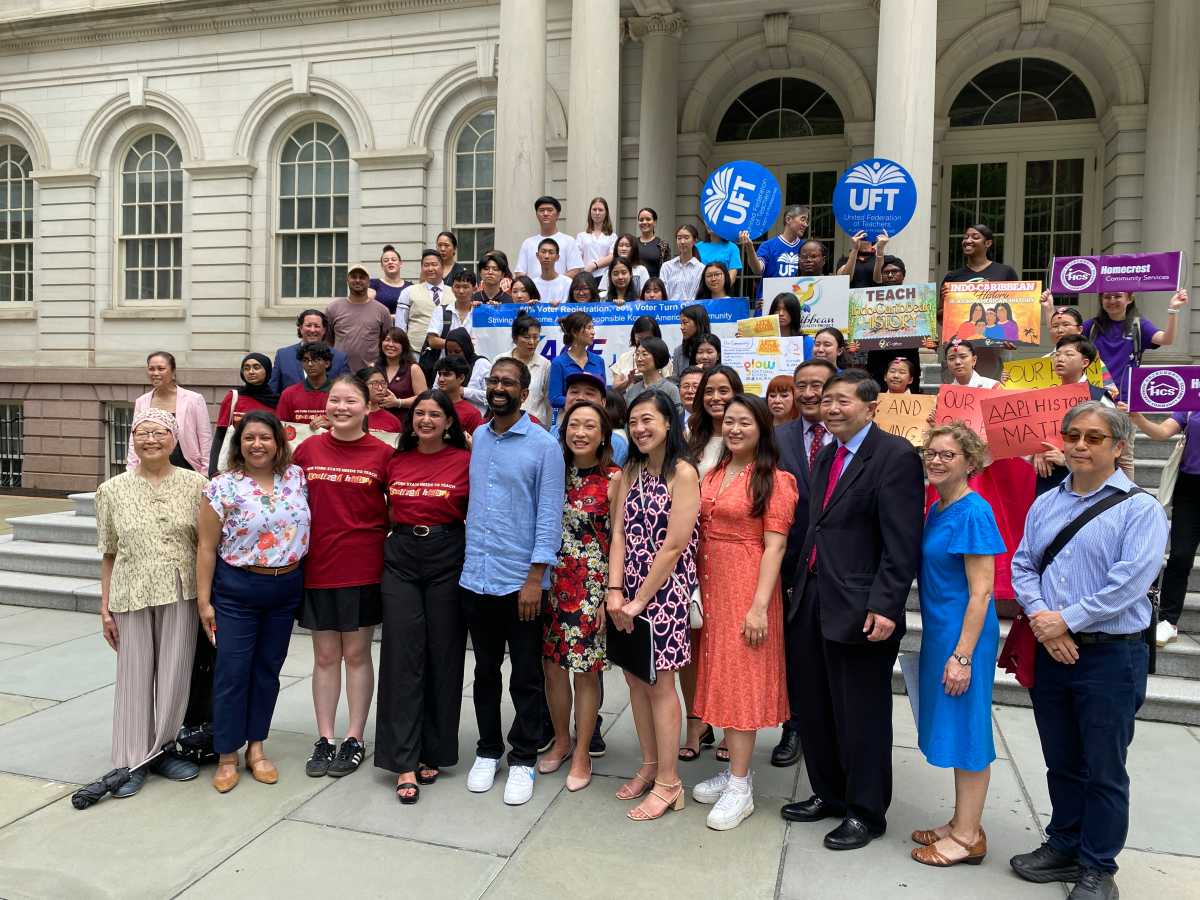By Albert Amateau
The Landmarks Preservation Comm-ission on Tuesday told St. Vincent’s Hospital and the hospital’s redevelopment partner, the Rudin Organization, to go back to the drawing board and come up with an entirely different project than the one submitted on Dec. 31.
The commission did not officially vote at its May 6 meeting, but every member made statements that they would not approve demolition of all nine existing buildings on the hospital campus in the Greenwich Village Historic District. They also said the proposed 329-foot-tall new hospital and the proposed 265-foot-tall residential building, intended to help pay for the hospital, were both too big to be in the historic district.
“There is room for much thought — rethinking — which clearly will result in another proposal that would warrant approval — a new proposal that goes through the community board,” said L.P.C. Chairperson Robert Tierney, summing up at the end of a two-and-a-half-hour meeting at which St. Vincent’s representatives responded to commissioners’ questions.
The size of the proposed hospital on the west side of Seventh Ave. and the demolition of St. Vincent’s O’Toole building to make way for it were prime sticking points for the commissioners. So was the proposed demolition of all eight buildings on the main hospital campus on the east side to make way for the high-rise residential building on Seventh Ave. and two rows of townhouses in the midblocks of W. 12 and W. 11th Sts.
The proposed redevelopment requires L.P.C. approval because the hospital is within the Greenwich Village Historic District designated by L.P.C. 39 years ago. The project would also require approval of the City Planning Commission for variances for buildings larger than current zoning allows.
Landmarks’ overwhelming rejection of the project was welcomed by preservationists, neighborhood block associations and Community Board 2, which passed a resolution in March opposing the demolition of several of the buildings, including O’Toole, which was built in the 1960s for the National Maritime Union and designed by Albert Ledner, a student of Frank Lloyd Wright.
Brad Hoylman, chairperson of Community Board 2, said later, “I was particularly heartened that the commissioners cited the O’Toole building as deserving of preservation on every level, since Community Board 2 has been somewhat of a lone voice in advocating its protection.”
Indeed, all 10 commissioners at the hearing made special mention of the O’Toole building. One of them suggested that O’Toole might serve as the base of a new hospital building and another suggested that the inside of O’Toole, now used for outpatient service, could be converted to inpatient service. However, most commissioners said the exterior of the building should be preserved entirely.
But Henry Amoroso, St. Vincent’s president and C.E.O., issued a statement later that the hospital would seek a hardship exemption to demolish the O’Toole building in order to build a state-of-the-art hospital on the site. Amoroso also said St. Vincent’s would be ready to amend its Landmarks application if Rudin decides to modify its plans for residential development on the east side of the avenue.
The Landmarks Law allows nonprofit organizations like St. Vincent’s to apply for a hardship exemption in situations where the commission disapproves a demolition, but only if the organization can prove that the existing building is not usable for its charitable mission.
“The reality is that the O’Toole site is the only location where we can build a fully efficient, state-of-the-art, green hospital to serve the people of New York,” Amoroso said. “We are committed to continuing our more-than-150-year mission of providing quality healthcare. … And we will return as soon as possible to the Landmarks Commission with a hardship application for the demolition of the O’Toole building,” Amoroso said.
However, the strong statements by Landmarks commissioners vindicated preservationists, including Andrew Berman, Greenwich Village Society for Historic Preservation director, who has long sought a smaller project with conversion of some of the existing hospital buildings to residential use.
“The L.P.C. reaffirmed that it is committed to preserving the meaning and intent of the Landmarks Preservation Laws,” Berman said after the meeting. “A new plan should preserve and reuse the significant buildings on the site.”
Trevor Stewart, a board member of 175 W. 13th St., a block away from the hospital, said the commission “really understood the issues.”
Thomas Molner, a founding member of Protect the Village Historic District, a group organized to stop the current plan, said, “What we are seeing today is a real passion for historic preservation.”
Hoylman later recalled that in 1979 St. Vincent’s received approval from L.P.C. to demolish the historic Seton and Lowenstein buildings.
“Nobody is getting a blank check this time around,” he said.
Jo Hamilton, a Community Board 2 member, said after the meeting that the board, along with the Municipal Art Society, the Historic Districts Council and Docomomo, a group that seeks to preserve modern architecture, were the early advocates of preserving the O’Toole site.
In addition to the O’Toole building, commissioners on Tuesday cited the Nurses Residence, the Smith and Raskob buildings, all on 12th St., and the Spellman building on 11th St. as worthy of preserving.
The high-rise, brick Coleman building on Seventh Ave. and the adjacent Link building, where St. Vincent’s emergency room entrance is located, were both deemed to be dispensable. Some commissioners said the Cronin building could be demolished without detracting from the historic district. And the hospital’s Reiss building was generally excluded from the list of buildings that should be preserved.
Shelly Friedman, land-use attorney for the project, responding to questions from commissioners, said the Spellman building was not suitable for residential conversion because it had relatively sparse window space, only 20 percent of the facade.
Nevertheless, commissioners seemed to favor an alternative that involved converting the Nurses Residence to residential use by extending it back into the rear yard opposite the rear yard of Spellman, which they also suggested could be converted to residential use.
“This is a historic district,” said L.P.C. Commissioner Pablo Vengoechea. “It does not call for a principle of ‘knock everything down and begin again.’ That’s the wrong approach.”
“Why should O’Toole be sacrificed so that Rudin can build a huge private housing project?” asked Commissioner Margery Perlmutter. She went on to blame St. Vincent’s, which recently emerged from bankruptcy, for getting into trouble because of bad management.
Commissioner Diana Chapin said the proposed hospital and the residential high-rise are both too big to be in the historic district and the ellipsoid shape of the proposed hospital is not appropriate. The townhouses proposed for the midblocks of 11th and 12th Sts. “look like suburban imitations,” Chapin said.
“This is a serious assault on the Landmarks Law,” Roberta Brandes Gratz, another commissioner, said of the project. “Although it would not legally be a precedent, it would be naive to think that other worthy institutions would not claim to deserve the same consideration.”
Hoylman said he looks forward to C.B. 2 weighing in on the project’s redesign.
“It’s clear to me that we are at the beginning of a longer conversation about the project,” Hoylman said. “Community Board 2 will continue to work closely with elected officials, neighbors, St. Vincent’s and the Rudin Organization to come up with a reasonable plan. I’m extremely optimistic that a solution can be found that meets both the community’s and the hospital’s needs.”





































